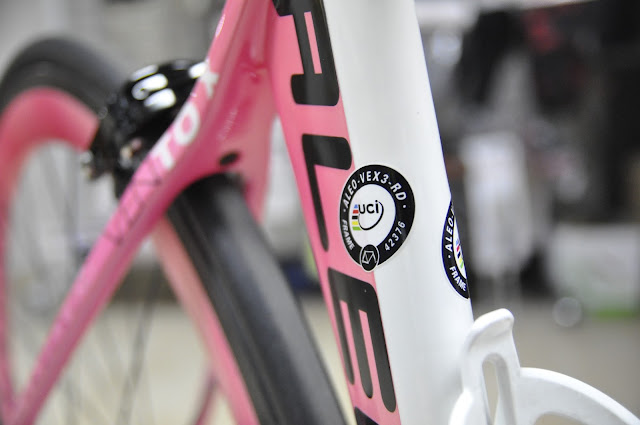< The Bicycle Makers >
"A bicycle, often called a bike or cycle, is a human-powered, pedal driven, single track vehicle having two wheels attached to a frame, one behind the other." - Online definition
The company I have chose to work with isn't just any other bicycle manufacturer (thousands in the world), Aleoca Pro Singapore is the only Singapore Home-Based bicycle brand that produces bikes locally and abroad. To be able to work in such a prestigious and home grown company definitely makes me feel proud!
The Aleoca Logo (2009 - Present)
Established in 1996 with the mission "To build quality and affordable bicycles for all types of cyclist", Aleoca has definitely delivered and has kept that mission in mind til today.
As I have mentioned in my previous post, they manufacture all sorts of bicycles to tailor every different type of customer.
After speaking to the boss of the company, I am inspired by his motivations and true beliefs in the managing of his business. He truly believes that bicycles should be kept affordable and attainable to everyone no matter what age or social status.
A rugged mountain bike for off road use
Bicycles built by the company can range from under a $100 all the way to $800. And in the recent years, the company has recently spent plenty of time and research to develop a new high-end line of high performance race bicycles that cost well over $3,000 each. (My most favourite segment to talk about in the coming weeks)
After spending a week in the warehouse carrying out both observation and hands on work. I've gotten a very good feel of the types of bicycles they work on and also how different every bicycle is. Aleoca has close to hundreds or even thousands of different models, so remembering every single one of them is definitely a daunting task.
I'm thankful that in my first week of work, the assembly staff workers ( a mix of China and Indian nationals) were very friendly and very welcoming to help guide and teach a new guy like me!
Here are a few glimpses of my practical hands on phase with assembling new bicycles:
Part 1: Arrival of new bikes
The warehouse office is stockpiled with mountains of cardboard boxes like those shown above. All of these boxes contain a brand new bicycle that is 60% into completion. These bikes are more commonly flown in from the full manufacturing plants in China. Plenty of containers bring these in every month to replenish the local stock.
The bikes in these boxes as mentioned, are a little more than half completed. The main structure of the bicycle is ready, just that the components like the handlebar, seat, pedals, gears and brakes, are not fit in properly.
The job for us is to then assemble all components properly and make sure they work perfectly (The tuning part is the most challenging)
The bikes are all properly wrapped up and safely packaged to prevent any extra damage to the components.
With all the different tools and equipment, each is then carefully put together by hand and with patience!
Part 2: Basic Assembly
(Left) Shows the unassemble handlebar and wheel (Right) A box of accesories including the saddle(seat) the pedals and cables etc. All of these items arrive inside the same cardboard box as shown in part 1.
A representation of all the different bike tools the assembly workers are given. (Alot more)
Part 3: Fine Tuning and Completion
When i first assembled my first bike, with guidance and help, the feeling of accomplishment was so satisfactory. :)
But in subsequent bikes I did make mistakes and the workers were still very nice and guided me every step of the way. It's always better to make mistakes and troubleshoot them. This not only makes me analyse, but it also gives me better knowledge.
All the skills i learnt will definitely come in to play when I deal with customers in the future. As my supervisor told me, "As an engineer, you must be super aware of every single detail and part of your product. When problems arrive, always analyse and make use of knowledge and brain-storming to solve the issue."
Here are a few pictures of some completed bicycles that I myself assembled and tuned. In one week alone I probably learnt and worked with more than 20 types
One of the simpler and easier bikes to assemble. Due to the lack of extra features like suspension and wider gears, this bicycle is very affordable and easy to use.
Something more common nowadays - A foldable bicycle. What I've learnt is that it's really important to make sure all the joints of the folding mechanism are properly fastened.
A more modern and classy looking City Bike. City bikes are tailored for urban riding at a more relaxed pace. The brakes for these bikes are specially designed (Will have a separate post on that).
Those above are just a few of the many different models I've worked on the past week. I have alot more pictures about Carbon Fiber bicycles which I will update in the next post.
Some important takeaways from this week:
- Always important to be precise in your work. (Adjusting of brakes, screws etc. as these concern our user's safety)
- Communication is very important. The workers (some China and Bangladesh) somehow still manage to communicate even though they do not speak proper English. Initially I struggled understanding both parties even though they were all very eager to help me. A very friendly and welcoming bunch!
- Passion and Knowledge. As mentioned earlier I'm a very avid cyclist. To be able to learn so much in just one week is something that I'm really happy and satisfied with.
More technical specs of bicycle braking and my takeaways will be coming soon, stay tuned!
Looking forward to the start of Week 2 tomorrow :)





























